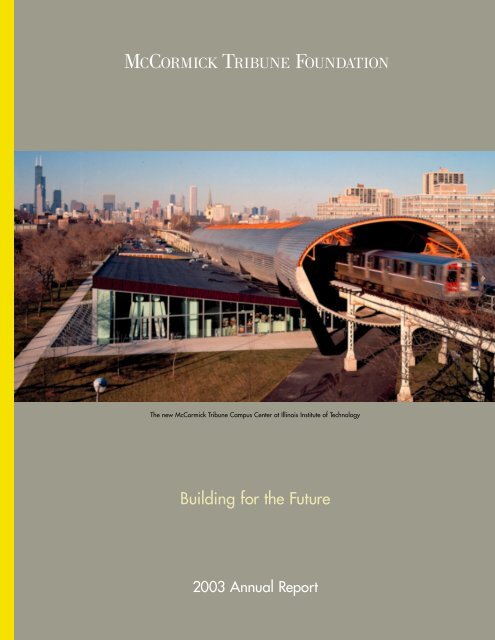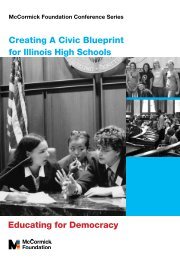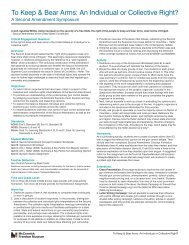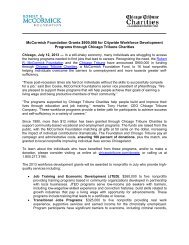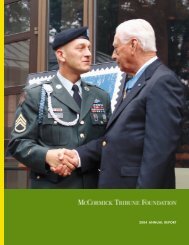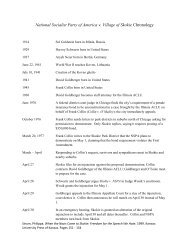Full Report - McCormick Foundation
Full Report - McCormick Foundation
Full Report - McCormick Foundation
- No tags were found...
Create successful ePaper yourself
Turn your PDF publications into a flip-book with our unique Google optimized e-Paper software.
The new <strong>McCormick</strong> Tribune Campus Center at Illinois Institute of TechnologyBuilding for the Future2003 Annual <strong>Report</strong>
A Brief History of the <strong>Foundation</strong>The <strong>McCormick</strong> Tribune <strong>Foundation</strong> wasestablished as a charitable trust in 1955upon the death of Colonel Robert R.<strong>McCormick</strong>, the longtime editor and publisherof the Chicago Tribune. <strong>McCormick</strong> played amajor role in American journalism during thefirst half of the 20th century and built the TribuneCompany from a single newspaper into a majorColonel <strong>McCormick</strong> dedicates the WGN building in 1950, an eight- and eleven-story addition to the Tribune Tower. The Tower celebrated its25th anniversary the same year.media organization, consisting of newspapers,radio and television stations, and newsprint manufactories.<strong>McCormick</strong> also served in the UnitedStates Army with the Mexican ExpeditionaryForces under General Pershing and subsequentlyunder the general in France during World War I.In that war he fought as an artillery battalioncommander with the First Division, and formany years afterward, he remained active in theArmy Reserves. These associations resulted in astrong bond between the colonel and the military,particularly the First Division.In his will Colonel <strong>McCormick</strong> specifiedonly that his fortune be used for “religious, scientific,literary, and educational purposes, or for the preventionof cruelty to children or animals.” Thishas allowed the foundation to support a widevariety of efforts, ranging from the physical propertiesof the Cantigny estate and the First DivisionMuseum through philanthropic support of itsmission in communities, education, journalism,and citizenship.Table of ContentsMessage from the President......................................2Key Events of 2003 ....................................................4Special Initiatives ........................................................6The Communities Program....................................10The Journalism Program.........................................16The Education Program..........................................22The Citizenship Program .......................................282003 Communities Grants Highlights ................342003 General Fund Grants.....................................38Summary of 2003 Grants Paid ..............................422003 <strong>Foundation</strong> Financial Highlights ................43<strong>McCormick</strong> Tribune <strong>Foundation</strong> Staff ................46<strong>McCormick</strong> Tribune <strong>Foundation</strong>Directors and Officers .............................................48
2003 Annual <strong>Report</strong>
Message from the PresidentThe <strong>McCormick</strong> Tribune <strong>Foundation</strong> executive team, pictured at the dedication of the new <strong>McCormick</strong> Tribune Campus Center at Illinois Institute ofTechnology. From left to right: Louis J. Marsico, Vice President of Finance and Administration; Richard A. Behrenhausen, President and CEO;Nicholas Goodban, Senior Vice President of Philanthropy; David L. Grange, Executive Vice President and COO.Colonel Robert R. <strong>McCormick</strong> appreciatedarchitecture for its aesthetic appeal. Whenhe conducted his world-famous competitionfor the Tribune Tower design in 1922, he considereda range of concepts before choosing a Gothic design.To the Colonel, architecture was a way to appreciatehistory, to evidence his community pride, and to putforth his own deeply held personal philosophies.2
Key EventsThe following were among the manyfoundation-supported events in 2003:JanuaryWith a musicalcareer spanningfive decades, BillRusso, belovedfounder of theChicago JazzEnsemble–a foundationgrantee–passes away at age 74.February<strong>Foundation</strong> grantee the Day CareAction Council of Illinois, alongwith parents and child care providers,urge Illinois lawmakers to raise childcare income eligibility guidelinesto 2003 levels.MarchThe foundation co-hosts theCantigny Conference, “Dirty Wars,”with Boston University, which probesthe sensitive issue of achieving a balancebetween international laws thatprotect prisoners of war and intelligencegathering.AprilThe American Red Cross of GreaterChicago breaks ground for the newfoundation-funded Disaster OperationsCenter.The <strong>McCormick</strong>Tribune FellowsInitiative publishes“Executives ofColor: What ItTakes To Succeed,”a thoughtfullook at the challenges executives ofcolor perceive.MayWith foundation support, MundeleinSeminary breaks ground for the FeehanMemorial Library Extension, whichwill house a viewing gallery for its rarematerials and special collections.AMVETS and the foundation dedicatea memorial carillon in HenriChapelle, Belgium, to honor WorldWar II U.S. veterans.JuneDennis FitzSimons, foundation boardmember, presents a $250,000 grant insupport of the United Negro CollegeFund at the Black and White Ballgala event.With seven partner funds, the foundation’scommunities program launchesa new Internet-based fundraising initiative,the Donor Advised GivingProgram, which allows donors to contributeonline, earn a match on theirdonations, and make recommendationson which agencies they wishto support.The foundation sponsors theCantigny Conference, “The Role ofthe Military in Homeland Security,”which gathers experts from local,state, and national levels of lawenforcement; emergency response;public health; military; academia;and other fields to discuss the role ofthe military in post-9/11 America.Supported by a grant from the foundation,the Community VeteransMemorial Park in Indiana opens tothe public, featuring life-size monumentsof soldiers memorializingveterans of World War I and II,Korea, Vietnam, and Desert Storm.Five early childhood teachers arehonored during the annual Kohl<strong>McCormick</strong> Early ChildhoodTeaching Awards ceremony.JulyAs part of the foundation’s ServiceAmerica program, West Point Cadetsspend several weeks volunteering atlocal nonprofits and tutoring studentsin two Chicago public elementaryschools.Advancing Afterschool 2010:Creating a Roadmap for the Futureconvenes a group of 40 leaders inthe after-school field, resulting ina report outlining best practices inafter-school programs.Shedd Aquarium’s Wild Reef exhibit,which includes the <strong>McCormick</strong>Tribune Stingray Way, opens tothe public.The National Association of HispanicJournalists highlights its new “ParityProject” to help news organizationsdouble the percentage of Latinos workingin newsrooms within five years.AugustIn the seventh Cantigny militarymediaconference since 1992, topmilitary officers, journalists, andmedia executives assess military-4
media relations during the just-completedIraq war and recommendchanges to facilitate better coveragein the future.SeptemberThe $48.2 million dollar <strong>McCormick</strong>Tribune Campus Center at IllinoisInstitute of Technology opens, thefirst building completed in NorthAmerica by renowned Dutch architectRem Koolhaas.MTF and its communities programpartner, the Daily Press, launch fundraisingefforts in Newport News, Va.,to help the victims of HurricaneIsabel in the Virginia Peninsula area.Northwestern University’s MedillSchool of Journalism begins MTFfundedgraduate course, “CoveringConflicts,” providing 15 studentsintensive immersion in military strategyand operations, plus key insightsinto coverage of war, war crimes, terrorism,and peacekeeping.The foundation funds the Fort RileySesquicentennial Conference inKansas to celebrate the anniversaryand history of the Big Red One inits former home base of Fort Riley.Voices for Illinois Children hosts itsannual foundation-supported StartEarly professional development conferencein Chicago.OctoberWGN Radio 720 Neediest Kids Fundbecomes a beneficiary, along with theIllinois chapter of the Juvenile DiabetesResearch <strong>Foundation</strong>, of the 25thannual Ron Santo Walk for the Cure.The event raises more than $3 million.Communities program partners inSouthern California begin joint fundraisingin response to wildfires ravagingthe area. The campaign results infoundation grants of almost $2 millionto assist those in the nearly750,000 affected acres.Chicago and the foundation hostpublishers and editors from throughoutthe Americas for the 59th annualGeneral Assembly of the Inter AmericanPress Association.After an intense six-week trainingprogram, volunteers from City Year, afoundation grantee, embark on a 10-month program in which they participatein leadership development, civicengagement, literacy tutoring, andafter school programs.NovemberAs part of its Rey of Hope II campaignto expand their school servingyouth on Chicago’s West Side, CristoRey Jesuit High School opens thenew <strong>McCormick</strong> Tribune Lobby.American Society of NewspaperEditors <strong>Foundation</strong> completes the14th in a series of 24 seminars fornewspaper executives designed tohelp them implement the findingsof groundbreaking new newspaperreadership research.The Power of Documentation: Children’sLearning Revealed exhibit opensto more than 2,000 early childhoodeducators at Chicago Children’s Museum,coinciding with the NationalAssociation for the Education of YoungChildren’s annual conference.DecemberThe <strong>McCormick</strong> Tribune <strong>Foundation</strong>awards its billionth dollar to MetropolitanFamily Services, an organizationthat Colonel <strong>McCormick</strong> as wellas his grandfather, Joseph Medill,supported during their lifetimes.The foundation’s board of directorsconcludes the year by awarding $12.6million in grants nationwide, bringingtotal foundation giving in 2003 tomore than $88 million. In addition,the board approves the addition ofAtlanta-based WB36 Charities tothe communities program.5
Special InitiativesAmanda Alpert, left, and Suzanne Roth, <strong>McCormick</strong> Tribune Leadership Fellows at the University of ChicagoThe <strong>McCormick</strong> Tribune <strong>Foundation</strong> supportsa limited number of major institutions andprograms through its Special Initiatives category.These initiatives are generally within theChicago metropolitan region for projects andorganizations that do not fit within the foundation’sfour primary grantmaking categories.6
Preparing Chicago’s Future Leaders“Over time, theProgram will createa group ofcivic-minded leadersprepared toRobert T. Michael and Edward F. Lawlor work in tandem hoping to mold future Chicago leaders.In a unique partnership with twoschools at the University of Chicago,the foundation funded a fellowshipprogram intended to prepare a cadreof future leaders for Chicago.The Program for Urban andCommunity Leadership (the Program)joins students in the Irving B. HarrisGraduate School of Public PolicyStudies and the School of SocialService Administration in an intensivejourney that combines the strengthsof both schools.“The <strong>McCormick</strong> Tribune LeadershipFellows have been informed andinspired about Chicago and about theimportance of leadership in addressingthe challenges of urban living, andhave been exposed to the practical sideof urban public policy,” says RobertT. Michael, director of the FellowsProgram at Harris.His counterpart in the Program,Edward F. Lawlor, dean of the Schoolof Social Service Administration,echoes this sentiment. “The studentsare treating these fellowships as a wayto integrate their classroom experienceand their field education with anunderstanding of a set of importantissues that confront the city,” he says.Two of the Program’s students–Suzanne Roth and Amanda Alpert–attest to the benefits of this approach.“Through my participation in thisprogram, I have expanded my knowledgeof urban communities and theissues that affect them, and gained anunderstanding of the roles that individualsplay in community developmentefforts,” says Roth. She is a second-yearevening student at SSAwho works for the Mikva Challenge,a nonprofit whose goal is to engageChicago high school students in thepolitical process.Alpert, an administrator withChicago Public Schools, appreciatesthe networking and learning opportunitiesthat accompany the Program.“Over time, the Program will create agroup of civic-minded leaders preparedto work with the city and the surroundingareas on the issues and concernsof its communities.”work with the cityand the surroundingareas…”Amanda Alpert<strong>McCormick</strong> Tribune Leadership FellowUniversity of Chicago<strong>McCormick</strong> Tribune LeadershipFellows completecoursework as well as fieldexperiences in order tograduate from the program.7
Designing the FutureThe <strong>McCormick</strong> Tribune Campus Center atIllinois Institute of Technology, which openedSeptember 30, combines stunning, state-of-theartarchitecture with practical conveniences.The opening ofthe <strong>McCormick</strong>Tribune CampusCenter at IIT…marked a milestonefor thefamous design,architectural,and engineeringschool.While University of Chicagois building bridges betweenits students and the community,Illinois Institute of Technologybuilt its own “bridge” that connectsstudents, faculty, and visitors withone another–literally.The opening of the <strong>McCormick</strong>Tribune Campus Center at IIT (theCenter) in September marked a milestonefor the famous design, architectural,and engineering school.The first completed North Americanproject for renowned Dutcharchitect Rem Koolhaas, the $48.2million building located in the heartof IIT’s campus boasts many convenienceswithin its 110,000 square feet.Included are dining facilities,auditorium and meeting rooms, studentorganization offices, the campusbookstore, a coffee bar, a post officeand a convenience store.Above it, encased in a nearlysound-proofed, 530-foot stainlesssteel tube, is the elevated GreenLine train, which makes a stop abouta block south of the Campus Center.The foundation’s benefactor,Colonel Robert R. <strong>McCormick</strong>, tooka special interest not only in architecturebut also in improving Chicagoand making it a world-class city. TheCenter is another sign that the city’sSouth Side continues to be revitalized.8
Building a Better ChicagoThe Cosmic Gatewayprogram…through advancedtechnology, connectsclassrooms toJunior high school students visiting Adler Planetarium in Chicago communicate via satellite withastronauts aboard the International Space Station.Included among our other excitingspecial initiatives are grants to theAdler Planetarium and LincolnPark Zoo.Chicago has a wealth of culturalinstitutions and learning centers thatprovide educational opportunities tochildren in partnership with areaschools.One such organization is AdlerPlanetarium, which received fundingfor the Cosmic Gateway program that,through advanced technology, connectsclassrooms to science educationat the Adler. This technology allowedeighth graders at the Adler to communicatevia live satellite with astronautsworking on the InternationalSpace Station. The students askedquestions ranging from “how does thefood taste,” to “what does it feel liketo float”–giving inner-city youth theopportunity to consider the possibilityof their own dreams.Back here on Earth, children andtheir families are being entertained atLincoln Park Zoo by a new addition–the meerkat and aardvark exhibit.The exhibit, in the RegensteinAfrican Journey, recognizes the foundation’scontribution to the zoo’s endowmentcampaign, which allows its programsto remain free to the public andsupports its educational mission.science educationat the Adler.“Bill,” a meerkat housed withinLincoln Park Zoo’s RegensteinAfrican Journey exhibit, is oneof the zoo’s newer residents.9
The Communities ProgramMark Krieschen, general manager of WGN Radio 720 and head of the Neediest Kids FundIn partnership with newspapers and their readers,broadcasters and their listeners and viewers,and sports teams and their fans across the country,the communities program of the <strong>McCormick</strong>Tribune <strong>Foundation</strong> encourages charitable givingand seeks to improve the social and economicconditions of 30 communities nationwide in whichthese partners live and work.10
Encouraging Success in School“…Our model…can help someof our most disenfranchisedyoungpeople to reinvestLila Leff, founder and executive director of Umoja, encourages a Manley Career Academy student.One would expect to see thegeneral manager of a largemarketradio station seatedin his office, considering new programming,fielding calls from thepublic, and keeping an eye on competingstations.But on this day, Mark Krieschen,general manager of WGN Radio720, is visiting MTF grantee Umoja,housed within the Chicago PublicSchools’ Manley Career Academy.As WGN Radio 720’s general manager,Krieschen wears a second hatas the head of WGN Radio 720’sNeediest Kids Fund’s giving committee,a fund of the <strong>McCormick</strong> Tribune<strong>Foundation</strong>. Today’s visit is one wayin which Krieschen ensures thatNeediest Kids Fund support is on targetwith the needs of the community.Umoja offers a variety of services–includingtechnical training–toyouth attending Manley. The careeracademy serves some of the city’smost educationally and economicallychallenged young people, and sinceUmoja’s launch in 1997, the graduationand off-to-college rates of participatingstudents has increased by 500 percent.These results are reassuring to Krieschenand his giving committee.“(Manley) has been an excellentplace for Umoja to demonstrate thatour model is effective and can helpsome of our most disenfranchisedyoung people to reinvest in themselves,their education, their future, and theircommunity,” says Lila Leff, founderand executive director of Umoja.She credits the Neediest KidsFund with being among the first toinvest in Umoja, providing leverageto earn other funding.Krieschen knows firsthand theimpact business can have on strengtheninga community’s resources, andexplains that a dedicated staff makesbalancing his double duties easy. “Now,I have the opportunity to run the station,get involved in our community,and work with a great group of people.”in themselves,their education,their future, andtheir community.”Lila Lefffounder and executive directorUmojaSince Umoja’s 1997 launch, off-to-collegerates of Manley students like these hasincreased by 500 percent.11
Showing Community ResponsibilityChildren learn expression through art duringan Inner-City Art activity.The LA Times Family Fund reaches out to the community in part by making grants like this one,which funds art education to second and third graders.A child works independentlyon an art project.12Newspapers shoulder a heftysocial responsibility, not justin accurate reporting, but alsoin improving their neighborhoods.The Los Angeles Times finds manyways to demonstrate its commitmentto the community. A partner withMTF’s communities program, thenewspaper is doubling the efforts ofits LA Times Family Fund, a fundof the foundation.“In the five-county area we serve,homelessness is growing, the needsof special needs or disabled childrenare growing, and the food banks aredesperately searching for contributors,”says Gisselle Acevedo-Franco,vice president/public affairs for theLA Times.The LA Times staff decided toexpand the reach of the Family Fundon every front, from increasing donorlists and advertising to hiring new andcreative staff members to manage it.“I think the most importantstrength I have is my understandingof philanthropy,” says Chia Yen,development director at the Fund,whose previous experience with largeinstitutions has been an asset in bringingnonprofit know-how to a fastpacedentrepreneurial environment likethe LA Times. “For me, the hardestchallenge has been getting to know allthe nonprofits the Family Fund supportsand serves. But I should alsomention that it has been a blessing aswell. Getting to know them givesmeaning to my work.”So far, the response has been positive–Acevedo-Francopoints out thefiles of thank-you notes that suggestthe Fund is on the right track. Yet,“You have to be committed to multipleavenues, including in-paper space,direct mail, telefunding, which is a newmethod we tried this year, public serviceannouncements, and radio,” sheexplains. “People need to hear and seeyour message many times before itclicks that we are part of this communityand we are making a difference.No one person learns in one way, soyou must continue to try to reach andteach people about your efforts in everystyle possible, to be truly successful.”
The Communities ProgramGisselle Acevedo-Franco, vice president/public affairs at the Los Angeles Times, and Chia Yen, development director at the LA Times Family Fund“People need to hear and see yourmessage many times before it clicksthat we are part of this communityand we are making a difference.”Gisselle Acevedo-Francovice president/public affairsLos Angeles Times13
The Communities ProgramRebecca Polihronis, left, manager of community relations for Cubs Care, and Sister Marguerite Bartling, program director at House of the Good Shepherd“If a mother can’t support herself,economic necessity may force her toreturn to an abusive relationship…”Sister Marguerite Bartlingprogram directorHouse of the Good Shepherd14
Developing Stronger FamiliesStaff at House of the Good Shepherd assist survivors of domestic violence toward financial andemotional independence.After the heartbreak of the2003 baseball season, Cubsfans everywhere resurrectedtheir familiar mantra: “there’s alwaysnext year.” But off the field, 2003was yet another championship yearfor the Cubs.Through its support of sportprograms for youth and the disabled,the Cubs reach beyond the friendlyconfines of Wrigley Field by makinggrants through Cubs Care–a<strong>McCormick</strong> Tribune <strong>Foundation</strong>fund–to area nonprofits that meetCubs Care guidelines.But what sets Cubs Care apartfrom many team-affiliated charitiesis that it also focuses on anothermore serious issue–domestic violenceprevention.“Domestic violence is very prevalentin a city the size of Chicago,”says Rebecca Polihronis, manager ofcommunity relations for Cubs Care.“There are not that many sheltersor agencies available to help thesewomen and their families.”Cubs Care, for instance, currentlysupports House of the GoodShepherd, which has a capacity for 14families; most stay about four months.The intensive program promotes healingand recovery for women and childrencaught in the cycle of domesticviolence, and also teaches independenceand self-sufficiency.“MTF has provided importantsupport of our education services,” saysSister Marguerite Bartling, programdirector at HGS. “If a mother can’tsupport herself, economic necessitymay force her to return to an abusiverelationship simply because she hasnowhere else to live. Therefore, westress education and job skills as criticalcomponents of our recovery program.”Ninety percent of the womenwho have entered HGS’s residentialprogram in recent years have movedon to stable, more independent housing.Follow-up telephone calls to formerresidents who left up to two yearsago indicate that 96 percent remainedfree of domestic violence.“We are deeply grateful to the<strong>McCormick</strong> Tribune <strong>Foundation</strong> forhelping to make these successes possible,”Sister Bartling says.House of the Good Shepherd facilitiesallow families to stay for extendedperiods of time to recover fromthe cycle of domestic abuse.15
The Journalism ProgramSergio Muñoz, head of the Chapultepec project and editorial writer for the Los Angeles TimesThe journalism program seeks to promotethe development of effective and farsightedleadership for news organizations, championfreedom of expression and diversity of staffingand content for all news media, support theMedill School of Journalism at NorthwesternUniversity, and encourage full, informed coverageby the media of national security issues.16
Celebrating Freedom of the Press“To protect the livesof journalists isby far our mosturgent task.”Sergio Muñozeditorial writer, Los Angeles Timesdirector, Chapultepec projectIAPA members spend an evening at Chicago’s Field Museum.The movement toward a freepress in the Western Hemispheremade a significant stop inChicago this year, when the foundationco-hosted the Inter AmericanPress Association’s (IAPA) annualmeeting. The conference providedhundreds of publishers and editorsfrom throughout the Americas abreak from their hectic–even dangerous–day-to-dayschedules to reflecton their experiences, hear the similarchallenges others face, and glean newinformation to help them betteraccomplish their missions.The gathering was sweetened bya foundation-funded private performanceof the Chicago Symphony Orchestra,where IAPA delegates joinedhundreds of leaders of Chicago’sLatino community.“To protect the lives of journalistsis by far our most urgent task,”explains Los Angeles Times editorialwriter Sergio Muñoz of his work ashead of one of one of IAPA’s mostimportant undertakings, the Chapultepecproject. The project promotes theDeclaration of Chapultepec, a freepressmanifesto now approachingits 10th anniversary. By signing theDeclaration, leaders of more than20 nations have agreed to end violenceagainst journalists, insult laws,and other tactics designed to preventjournalists from fulfilling their dutiesas reporters.“Yet, there are many other taskswe must focus on,” Muñoz says. “Weare trying to build bridges of understandingbetween journalists andjudges and legislators and businesspeopleand communities at large, sothat we all understand why freedomof the press benefits society at large.”At two assemblies a year, IAPAmembers hear reports on the state ofpress freedom. “Based on these individualreports, the assembly issuesresolutions, and sometimes agrees tosend missions to countries where theattacks against freedom of the pressare unbearable,” Muñoz explains,adding that it is done to make officialsaware of the situation, and evento seek a remedy.Jack <strong>Full</strong>er, left, president of Tribune Publishingand a foundation board member, becomesIAPA’s new president during the annual meeting.Daniel Barenboim prepares theChicago Symphony Orchestrafor a special performance forIAPA attendees.17
Joining Together to Fight SecrecyUsing the Internet for gathering informationabout the government has become moredifficult in the wake of September 11.Doug Clifton and his staff at The Plain Dealer talk through the day’s news and photos.Editors continue searchingfor ways to keep governmentinformation availableto the public.18Adefinitive line is formingbetween the pre- and post-September 11 worlds when itcomes to access to information aboutgovernment and other public mattersin the United States. Security concernsand changing government policies inthe wake of the terrorist attacks havecreated a challenging environmentfor journalists, who believe manytraditionally open doors to informationabout public business are nowbeing shut.“The penchant for secrecy isgrowing daily, not just on the federallevel but at every level of government,”says Doug Clifton, editor ofCleveland’s daily newspaper, The PlainDealer, and chairman of the AmericanSociety of Newspaper Editors’(ASNE) Freedom of InformationCommittee. “Oddly, citizen supportfor openness is slipping as fear ofterrorism rises and concern over lostprivacy increases. That makes the jobeven harder because the politiciansrespond better to citizen concernsthan to media ones.”In response to this trend, MTF’sjournalism program made a series ofgrants to various organizations, includingASNE’s foundation, to explore andrespond to increasing attempts to closeoff the press from basic information.ASNE’s grant allowed it to convene aconference to enable openness advocatesto better understand and react to theshifting relationship between nationalsecurity and access to information.“In the end we decided to forma coalition of journalistic groups sothat we could more quickly respondto threats, enhance coordinationamong groups, reduce redundancy,and better align our collective efforts,explains Clifton.”Though the current environmentwill require patience as journalists continuetheir goal of accurate reporting,Clifton and his colleagues remain optimistic–and,he says, “MTF has beenconsistently supportive of press freedomand freedom of informationissues. The foundation always offers asympathetic ear and follows throughwith financial and spiritual support.”
The Journalism ProgramDoug Clifton, editor of Cleveland’s The Plain Dealer and chairman of the American Society of Newspaper Editors’ Freedom of Information Committee“The penchant for secrecy is growingdaily, not just on the federal level butat every level of government.”Doug Cliftoneditor, The Plain Dealerchairman, American Societyof Newspaper Editors’ Freedomof Information Committee19
The Journalism ProgramJack <strong>Full</strong>er, president of Tribune Publishing“There’s more mutual respect, which isin part the consequence of workingtogether on the battlefield.”Jack <strong>Full</strong>erpresidentTribune Publishing20
Bridging the Military-Media GapWalter Rodgers, CNN’s seniorinternational correspondentbased in London, reportedfrom the U.S. Army’s 7thCalvalry as an embeddedjournalist in Iraq.John McWethy (center), chief national security correspondent for ABC News, drives home a pointduring the Military and the Media conference at Cantigny.Relations between military andmedia always have been strained,and for understandable reasons:balancing their differing missions is achallenge. Nevertheless, since 1992,the foundation’s journalism programhas been helping facilitate a balancethrough its “Military and Media”conference series, a biennial gatheringof top military and media experts.In addition to airing concernsand potential solutions for compromise,the conferences encourage relationship-buildingand thoughtful discussionsin a neutral environment.Jack <strong>Full</strong>er, president of TribunePublishing and a member of MTF’sboard–himself a veteran of reportingon military conflict–opened the firstconference in 1992 and closed thisyear’s with thoughtful reflections onhow the relationship has evolved.“There’s more mutual respect,which is in part the consequence ofworking together on the battlefield,”<strong>Full</strong>er said. “It’s only a slight overstatementto say that back at the timeof the first conference there was hor-ror among the military people at theprospect… of trying to fight a warwith real-time, live coverage fromthe battlefield.” However, he said,now it was evident the militarybecame sophisticated about mediaand learned to use them to the advantageof a mission, as journalists whowere embedded with military unitsfelt emotional bonds with the soldiers,which brought an importanthuman element to the reporting.Though he felt this was positive,he cautioned journalists: “The issuefor us is to try to balance the deepemotionality and appeal of that partof what we do with the more cerebral,distant, skeptical side of what we do,which is to try to understand what’sreally happening in the large senseand the long-term significance of itfor our country.”Like all relationships, the onebetween military and media presentschallenges–but keeping the doors openfor communication is key to achievingappropriate coverage of conflicts.Dele Olojede, Newsday’s foreign editor,participates in discussions about news coverageduring the Iraq war.21
The Education ProgramTom Sergio Layman, Muñoz, executive Chapultepec director Committee of the Chicago director, Metro discussing Association press freedom for the Education issues with of committee Young Children, members. and Lorem Octavia ipsum Durham, feguiat. Professional LearningCommunities facilitator for the Association22The education program seeks to improve thequality of early childhood education byincreasing the number of accredited preschoolprograms in Chicago’s low-income communities,enhancing the skills and recognition ofpreschool directors and teachers, improving theearly childhood education system, and heighteningpublic awareness of the importance of earlychildhood education.
Opening Lines of Teacher Communication“I feel good aboutthe information theteachers sharewith each other,and how muchTeachers attending the Association’s annual conference stopped at the Chicago Children’s Museumon Navy Pier, which featured an exhibit entitled “The Power of Documentation: Children’s LearningRevealed.”Using young children’s schoolwork to measure how theydevelop in their environmentsis proving to be among the mostinspiring new ways early childhoodteachers are forming their curricula.“We had a child at (one center)who drew two pictures of a truck ontwo different occasions,” says TomLayman, executive director of theChicago Metro Association for theEducation of Young Children (theAssociation). One of the pictures wasquite detailed, while the other wasfairly crude. “We realized that whenthe child made the first one, she wasin a quiet, calm environment, whereasthe second drawing was made in anoisier environment, where she hadtrouble concentrating. We could seethat for her to do her best work, sheneeded to be in a quiet place.”Teachers must recognize behaviorpatterns and use each child’s body ofwork to determine best teaching practices.The Association facilitated thislearning process through two foundation-fundedinitiatives, ProfessionalLearning Communities (PLCs), andan exhibit entitled “The Power ofDocumentation: Children’s LearningRevealed” at the Chicago Children’sMuseum.PLCs include workshops anddiscussion groups in which teachersshare their experiences to help bettertheir students’ learning outcomes.“Teachers are validated aboutthe work they do in the classroom,”explains Octavia Durham, PLCfacilitator for the Association. “Theysee that they really do have a lot ofknowledge; they just need help recognizingthat and applying it.”The Chicago Children’s Museumexhibit upholds similar goals. Featuringthe work of local children,hundreds of teachers visited the displayand discussed how their experiencesrelated to the visible outcomesin the displays.“They support each other,”Durham says of PLC participants.“I feel good about the informationthe teachers share with each other,and how much they know.”they know.”Octavia DurhamPLC facilitatorChicago Metro Association for theEducation of Young ChildrenProfessional Learning Communities encourageteachers to share their experiences andto learn from one another.23
Creating a Higher StandardStudents taking child development classes atOlive-Harvey College exchange ideas withone another and their teacher, Ivy Cobbins.Through a new faculty development initiative at City Colleges, Dr. Cobbins, center, feels arenewed sense of motivation in promoting student success.Aligning college courseworkwith national standardsincreases thelikelihood of a futureteacher’s preparednessin the classroom.Building a qualified early childhoodwork force has proven anationwide challenge, but CityColleges of Chicago is one step closerto reaching this goal.“We want to assure that our collegestudents are going to have therequisite knowledge and skills theyneed to be effective classroom teachers,”says Jana Fleming, Ph.D., executivedirector of child developmentstudies at City Colleges. Supported bya foundation grant, Fleming’s manygoals include providing professionaltraining for the child developmentfaculty across the seven campuses.“We found that we don’t all dothe same thing, and there are someareas where we could be more uniform,”explains Ivy Cobbins, Ed.D.,faculty member at City Colleges’Olive-Harvey College. “The mandateis to train students to becomeproficient in teaching children, andwe need to do our job well so ourstudents can do their job well.”Fleming asked faculty to developa list of topics in which they wantedadditional training. “It put the onuson them to decide the direction weneed to take, and they see they mustplay an active role in getting wherethey want to be,” Fleming explains.She believes the faculty fully supportsthe initiative, and Cobbins agrees.“The faculty interaction brings abouta heightened sense of motivation andinterest in promoting student success,”Cobbins says.Though there are many componentsin City Colleges’ plans forenhancing their child developmentprogram, such as aligning collegecourses with national standards, facultydevelopment is arguably among themore important because, as Flemingpoints out, there is a strong correlationbetween teacher education andthe quality of teaching provided.Unifying and strengthening CityColleges’ curriculum is a step towardguaranteeing that future teachers areprepared to enter classrooms withthe best tools to educate Chicago’syoungest children.24
The Education ProgramJana Fleming, Ph.D., executive director of child development studies at City Colleges of Chicago, and Ivy Cobbins, Ed.D., faculty member atCity Colleges’ Olive-Harvey College“We want to assure that our collegestudents are going to have the requisiteknowledge and skills they needto be effective classroom teachers.”Jana Fleming, Ph.D.executive directorof child development studiesCity Colleges of Chicago25
The Education ProgramJane M. Garza Mancillas, executive director of El Hogar del Niño and recent recipient of the Illinois Director Credential“They (institutionalize training) inother career fields, but this seemslike a first for early childhood…It makes a lot of sense.”Jane M. Garza Mancillasexecutive directorEl Hogar del Niño26
Blazing a Career PathKaren Bruning, center, career development director at the Network of Child Care Resource andReferral Agencies, confers with recipients of the Network-created Illinois Director Credential.Though research in the field ofearly care and education showsa strong correlation betweenteacher training and children’s learningoutcomes, developing guidelinesand standards for this advancedtraining is still in its infancy.The Illinois Network of ChildCare Resource and Referral Agencies(the Network) is continuing its pioneeringwork in the career developmentfor early childhood educationprofessionals by creating two foundation-fundedcomponents for teacherdevelopment and director certification:the career lattice and the IllinoisDirector Credential (IDC).“Early childhood practitionersconfront numerous obstacles as theyseek more education and training, andemployers face tremendous challengesin recruiting and retaining qualifiedstaff,” says Karen Bruning, careerdevelopment director at the Network.For this reason, the Network introducedthe career lattice, a professionaldevelopment system that identifieswhat courses and competencies teachersneed for career advancement.“There is no coherent career pathfor early childhood providers in Illinois,”Bruning explains. One problem is thatthere is a lack of uniform standards thatrecognize work-based experience andcommunity college courses as validcredentials to obtain advanced trainingor higher education–in addition tothe issue of access to courses, which islimited in some parts of Illinois.Early childhood directors facesimilar challenges. While they haveobtained leadership roles, they oftenlack certification of their educationaland field-related achievements. Tohelp overcome this barrier, theNetwork developed the IDC.“I wanted to document my experience,”says Jane M. Garza Mancillas,executive director of El Hogar delNiño. Mancillas, who obtained hercredential in the spring, feels institutionalizingtraining in the field legitimizesit as a career. “They do it inother career fields, but this seems likea first for early childhood,” she said.“It makes a lot of sense.”Creating uniform standardsand a credentialing systemfor early childhood practitionershelps to ensure thebest care for young children.27
The Citizenship ProgramTammi Sergio Jordan, Muñoz, left, Chapultepec Bronzeville Committee Military Academy director, discussing graduate and press scholarship freedom issues recipient, with committee and Jeannette members. Howard, Lorem counselor ipsum feguiat. BronzevilleThe citizenship program seeks to engageyoung people in civic affairs, strengthenthe nonprofit sector, honor patriotism, andfacilitate discussions of key issues affecting thenation’s future.28
Reaching Their <strong>Full</strong> Potential“Without a doubt,students in thisday and age haveserious financialissues that mayBronzeville Military Academy, a unique member of Chicago Public Schools, receives more than1,000 student applicants every year.With recent efforts underway to revitalize Chicago’sSouth Side, many believethe new building developments andthe rehabilitation of its older landmarkssignal the beginning of aturnaround.Included in this reawakening wasthe opening of Bronzeville MilitaryAcademy, which welcomed its firstclass of cadets in August 1999. Partof Chicago Public Schools, Bronzevilleis housed in the former headquartersof the “Fighting 8th,” thecountry’s oldest African-AmericanNational Guard regiment.It is not hard to see why morethan 1,000 students apply each year forthe school’s 150 slots–of the first graduatingclass of 104 students, Bronzevilleboasted a 90 percent off-to-collegerate, with 70 percent of those going onto four-year institutions.The foundation’s longstandingsupport of military efforts through itscitizenship program, coupled withBronzeville’s remarkable early success,led to foundation-funded collegescholarships for five members of theclass of 2003.“Without a doubt, students inthis day and age have serious financialissues that may prevent them fromgetting to college,” says JeannetteHoward, counselor at Bronzeville whooversaw the scholarship committee.“I make all the announcements aboutscholarships, and when I put thisbulletin up, they all came running.”Howard and fellow committee membersmade decisions based upon gradepoint averages, school and communitycontributions, and interviews withalmost 20 applicants.<strong>Foundation</strong> scholarship recipientTammi Jordan, now a freshman atUniversity of Illinois at Urbana-Champaign, says the stress of financialneeds in her first year of collegehas been greatly lifted. The scholarshipsupplemented her mother’sencouragement to go to college. “Myfirst year of college, I don’t really haveto pay for anything. It’s all taken careof,” she says. “I feel so blessed.”prevent them fromgetting to college.”Jeannette HowardcounselorBronzeville Military AcademyTammi Jordan, with a fellow Bronzevillealumnus, visits her former school.29
Supporting Resource OrganizationsPerformers with the Luna Negra Dance Theater practice moves with founder and artistic director,Eduardo Vilaro, who learned new financial moves from the Arts and Business Council of Chicago.Eduardo Vilaro worked with the Arts andBusiness Council to develop Luna Negra’sfive-year strategic plan.30As the curtain goes up and thedancers take their places, it isdoubtful they are thinking offinancial strategies that would ensurethe theater’s growth or security.But thanks to the Arts and BusinessCouncil of Chicago, the performersand choreographers of theLuna Negra Dance Theater–whosegoal is in part to break stereotypesof Latino traditions by presentingcontemporary Latin-American culture–arelearning how they canembrace the less romantic “dollarsand cents” side of their business.“We know what we’re doing asartists; we can do it with our eyesclosed,” says Eduardo Vilaro, founderand artistic director of Luna Negra,located on Chicago’s North Side.“But in reality, you need to create abusiness. It’s on that side that weneed guidance and mentorship.”To help foster this kind of infrastructuredevelopment, the Councilemploys its four core programs,which include locating and placingcorporate professionals onto nonprofitboards; providing consultants toassist with fiscal management andmarketing; hosting grant writingworkshops; and measuring the effectivenessof its assessment tool, whichdocuments an organization’s developmentand helps measure impact.Operating grants like the one thefoundation made to the Council “arethe backbone of any capacity-buildingservice organization,” says Joan Gunzberg,the Council’s executive director.“Part of the increasing demand for the(Council’s) programs stems from thefact that arts organizations are increasinglyaware of the stiff competition forpeople’s leisure time, as well as the needto become more business-savvy.”Vilaro illustrates this pointthrough the five-year strategic planthe Council helped to develop, whichcreated good faith with Luna Negra’sboard and encouraged sound fiscalmanagement.“It is extremely important that wehave resource organizations such asthe (Council) in order to have a thrivingarts community in Chicago,”Vilaro says.
The Citizenship ProgramReggie Winfrey, executive director of Citizens Information Service of Illinois“…all (aspects of the Future VoterProgram are) very important to educatingtoday’s youth on becoming a moreresponsible and informed citizen.”Reggie Winfreyexecutive directorCitizens Information Service of Illinois32
Getting Out the VoteWith staff member Candace Kendrick, ReggieWinfrey visits high schools to spread the messageabout the importance of voting.Demetrius Thomas, a senior and registered voter at Neal F. Simeon Career Academy, discussesthe reasons young people should vote.Letting and keeping adults interestedin performing one of theirmost vital civic duties–voting–has proven a challenge for politiciansand civic rights groups alike. Hopingto prevent this attitude from formingin future voters, the Citizens InformationService of Illinois specializes incatching people early.Among CIS’s many youth-targetedinitiatives is the Future VoterProgram, which selects Illinois highschool students ages 16 to 18 tolearn more about civics via classroominstruction, community service, mockelections and debates, and Get Outthe Vote. The goal is to inform andeducate students, thereby encouragingthem to become more participatorynot just as future American voters,but as American citizens.Reggie Winfrey, executive directorof foundation grantee CIS, says theprogram’s many facets “are all veryimportant to educating today’s youthon becoming a more responsible andinformed citizen,” he explains.Today, Winfrey and CIS programofficer, Candace Kendrick, are registeringa classroom of 18-year-old seniorsat Chicago Public Schools’ Neal F.Simeon Career Academy to vote. Inthe classroom discussions, students talkabout things they’d want to change intheir community–such as long roaddelays–and learn which level of governmentaddresses which issue, howto reach the representatives, and howto make decisions on candidates.“Whatever they decide is what’sgoing to happen,” says senior DemetriusThomas–already a registered voter–ofelected officials. “You don’t want someonewho isn’t going to do anything, orsomeone who is just taking up space.”Thomas, who plans to attend collegein the fall, believes that every votecounts in an election. “If you don’tvote, you won’t make a difference,” heemphasizes. “It’s an important decisionin your life. You can’t change somethingwithout voting for the right person.”Candace Kendrickengages students incivic discussions.33
2003 Communities Grants HighlightsGuidelines for grant applications under the communities program may beobtained from participating corporate entities or from the <strong>McCormick</strong> Tribune<strong>Foundation</strong>. To find out if an agency qualifies for funding, grantseekers areencouraged to visit the communities program section of the foundation’s Website (www.mccormicktribune.org) prior to submitting an application.Allentown, PAMorning Call Charities$22,500Supports education and literacy programs forchildren, adults, and those with disabilities.Anaheim, CABaltimore, MDBaltimore Sun Charities$57,500Provides grants to organizations that assistchildren, youth, and families in need throughoutthe Baltimore metropolitan area.Boston, MAChicago Blackhawk Charities$500,000Supports programs for youth who are homeless,ill, abused, or otherwise at risk, andpromotes health, fitness, and teamwork.Chicago Tribune Charities$5,779,183Funds programs that promote child and familydevelopment, improve reading and literacy,and alleviate hunger.Angels Care$337,000Supports recreation, education, and healthprograms that assist underprivileged anddisabled youth.WB56 Family First Fund$693,800Primarily supports programs providing academicand social development to children andteens, such as mentoring programs, academictutoring, and peer leadership training.CLTV Kids Charities$375,000Supports health, welfare, and educationalprograms for children, with emphasis onchildren’s literacy programs.Mighty Ducks Care$490,000Funds programs that focus on children andyouth, education, health, and special needsin underserved communities.Chicago, ILBears Care$1,076,000Supports education, youth and families, athletics,entrepreneurship, and health programs,with a particular emphasis on programs aimedat disadvantaged youth.Cubs Care$920,000Funds neighborhood-based non-profit organizations,as well as programs that support childrenwith special needs, victims of domesticviolence, and youth baseball leagues.34
Denver, COWGN Radio 720 Neediest Kids Fund$997,000Primarily supports youth development andchildhood hunger programs; some holidayclothing and food for children.Colorado Avalanche Community Fund$519,000Supports children and families, violenceprevention, and youth health and sports.Post-News Season to Share Fund$1,554,000Supports programs addressing hunger,homelessness, and the needs of childrenand families.WGN-TV Children’s Charities$1,340,400Supports programs that benefit children, suchas early intervention, child abuse prevention,recreation, advocacy, child welfare, andholiday gift programs.Colorado Rockies Charity Fund$1,347,500Promotes participation in baseball and softballby people of all ages and abilities, and supportseducation, literacy, health, and youthdrug and alcohol abuse prevention programs.WB2 Charities Fund$2,377,500Funds organizations that promote the healthand well-being of children, youth, and families.Cleveland, OHCavaliers Charities$1,409,921Supports education, recreation, and employmentand life skills programs, primarily focusingon at-risk youth.Dallas, TXWB33’s Kids Fund$1,403,000Funds programs that focus on education andhealth initiatives for youth under the age of 18.Denver Broncos Charities Fund$1,384,000Supports programs that benefit youth athletics,education, the physically challenged, andat-risk children and their families.Denver Nuggets Community Fund$764,409Funds education, health, and youth programs,especially for at-risk or underserved children.Post-News Charities$1,739,500Supports programs that primarily aidyoung children from birth to 8, as well asliteracy and youth recreation initiatives inmetropolitan Denver.El Paso, TXThe Border Fund$1,935,400Supports programs that assist underprivilegedmembers of the community, such as the homeless,the disabled, and children.Ft. Lauderdale, FLSun-Sentinel Children’s Fund$2,426,825Funds programs that provide low-income childrenand families with food, shelter, emergencyassistance, health programs, abuse prevention,education programs, and holiday activities.35
2003 Communities Grants Highlights continuedGrand Rapids, MIFox 17 Charities Fund$137,000Funds programs that promote educationand public health awareness, as well asprograms that provide hunger relief andclothing for children.Fox 61 Family Fund$494,000Funds programs that support education, literacy,and family health awareness, as well asthose that prevent child and spousal abuse.Houston, TXLos Angeles Times Family Fund$2,478,650Supports programs that address the needs ofdisadvantaged children, youth, and families.Lowell, MAGreenwich, CTThe Advocate/Greenwich Time Holiday Fund$35,000Supports programs providing basic humanneeds and positive youth development to disadvantagedfamilies.Harrisburg, PAWB39 Cares for Kids Fund$1,009,000Supports organizations that promote thephysical and/or psychological well beingof children and their families.Indianapolis, INLowell Sun Charities$170,239Funds programs that support education, healthliteracy, cultural arts, youth, and communitydevelopment.Manhattan, KSFox 43 Charities$588,000Supports programs that assist with the basicneeds of children, youth, and families.Fox 59 Community Fund$165,000Funds organizations that focus on social, moral,emotional, and physical aspects of youth developmentfor adolescents ages 13 to 18.The Manhattan Fund$386,500Funds programs that promote arts education,literacy, and youth development; that alleviatehunger and homelessness; and that supportthose with developmental disabilities.Hartford, CTLos Angeles, CAMelville, NYThe Courant Community Fund$76,500Supports educational and other children andyouth programs, as well as family welfare programsthat strengthen the family structure.KTLA Charities Fund$1,809,500Provides funding for academic achievementinitiatives, child and youth development, healthprograms, holiday events for disadvantagedchildren, and programs that deter homelessnessand hunger.Newsday Charities$1,386,000Funds programs that support children andyouth, the elderly, arts and education, literacy,and community development.36
New Orleans, LAABC 26 Children First$342,000Provides funding for crime prevention, childabuse prevention, recreation, education, nutrition,and medical services.Orlando Sentinel Family Fund$2,002,914Supports programs that assist with the basicneeds of children and families, abuse preventionand literacy programs, and toy programs.Philadelphia, PANorth County TimesCharities Fund$877,000Supports programs for children and families,providing holiday gifts, food, clothing, andshelter, child abuse prevention/intervention,recreation, education, and adult andchildren’s literacy programs.Newport News, VADaily Press Holiday Fund$199,000Supports organizations that provide food,clothing, shelter, toys, and abuse preventionprograms for children and families.Philadelphia’s WB17 Cares$736,000Supports organizations specializing in theneeds of children and teens, primarilyfunding after-school programs that providefor academic and social development.Seattle, WAQ-13/WB22 Cares Fund$489,000Funds programs that enhance opportunities foryouth in education, health, and mentorships.New York, NYSacramento, CAWashington, DCWB11 Care for Kids Fund$810,500Supports funding for nonprofits in the Tri-Statearea that serve disadvantaged childrenthrough dropout prevention, abuse prevention,and health programs.Fox40 Helping Hand Fund$397,400Supports programs that address the health andwell being of children, youth, and families.San Diego, CAWB 50 Family Fund$121,000Supports programs that have a long-term positiveimpact on children and youth and thatstrengthen families.Orlando, FLOrlando MagicYouth <strong>Foundation</strong>$918,700Funds programs that support children consideredto be at risk as a result of physical, emotional,economic, or environmental challenges.KSWB Cares for Kids$2,251,100Funds organizations that specialize in the needsof children, with emphasis on programs thataddress the mental, emotional, and physicalwell being of underprivileged children.Total Communities Grants$47,329,44237
2003 General Fund GrantsAction Against Crime& Violence Education FundWashington, DC$50,000Adler PlanetariumChicago, IL$500,000Advertising Council Inc.New York, NY$50,000After School AllianceFlint, MI$8,500After School Matters Inc.Chicago, IL$100,000Alfred Friendly <strong>Foundation</strong>Washington, DC$40,000American Press Institute Inc.Reston, VA$165,000American Press Institute Inc.Minneapolis, MN$128,818American Red Cross ofGreater ChicagoChicago, IL$250,000American Society of NewspaperEditors <strong>Foundation</strong> Inc.Reston, VA$204,000AMVETS National Service <strong>Foundation</strong>Lanham, MD$50,000Arthur F. Burns Fellowship Program Inc.Washington, DC$25,000Arts & Business Council of ChicagoChicago, IL$25,00038Asian American Journalists AssociationSan Francisco, CA$80,000The Associated Press ManagingEditors <strong>Foundation</strong> Inc.New York, NY$25,000The Association of FundraisingProfessionalsNaperville, IL$25,000Atlantic Salmon Federation (U.S.) Inc.Calais, ME$50,000Big Shoulders FundChicago, IL$1,190,000Boys & Girls Clubs of ChicagoChicago, IL$500,000Bronzeville Military AcademyChicago, IL$25,000Cantigny First Division <strong>Foundation</strong>Wheaton, IL$1,641,537Cantigny <strong>Foundation</strong> Conference SeriesWheaton, IL$880,846Cantigny <strong>Foundation</strong> EducationConference SeriesWheaton, IL$141,838Cantigny <strong>Foundation</strong> JournalismConference SeriesWheaton, IL$438,467Cantigny <strong>Foundation</strong> OperatingWheaton, IL$2,485,611Center for Media and Security Ltd.Millwood, NY$70,000Center for Public IntegrityWashington, DC$80,000Center for Strategic andInternational StudiesWashington, DC$20,000Center for the Study ofthe PresidencyWashington, DC$50,000Centers For New Horizons Inc.Chicago, IL$220,000Centro de Periodistasde Investigacion, A.C.Mexico$50,000Charity Lobbying in the Public InterestWashington, DC$40,000Chicago Academy of SciencesChicago, IL$125,000Chicago Communities in SchoolsChicago, IL$175,000Chicago Community <strong>Foundation</strong>Chicago, IL$250,000Chicago Council on Foreign RelationsChicago, IL$175,000Chicago Crime CommissionChicago, IL$10,000Chicago Historical SocietyChicago, IL$300,000
Chicago Humanities FestivalChicago, IL$100,000Chicago Metropolis 2020Chicago, IL$328,000Chicago Metropolitan Association forthe Education of Young ChildrenChicago, IL$330,000Chicago Public Schools/Department of JROTCChicago, IL$50,000Child Care Coalition of Lake CountyLake Bluff, IL$50,000The Citadel <strong>Foundation</strong>Charleston, SC$25,000Citizen Advocacy CenterElmhurst, IL$28,000Citizens Information Service of IllinoisChicago, IL$50,000City Colleges of ChicagoChicago, IL$500,000City Year ChicagoChicago, IL$100,000Civil Society InstituteNewton Center, MA$140,000Civitas InitiativeChicago, IL$310,000Committee to Protect Journalists Inc.New York, NY$60,000Community Media WorkshopChicago, IL$45,000Community Renewal SocietyChicago, IL$203,500Constitutional Rights <strong>Foundation</strong> ChicagoChicago, IL$50,000Cristo Rey Jesuit High SchoolChicago, IL$200,000Current Links in EducationFlossmoor, IL$14,500Day Care Action Council of IllinoisChicago, IL$400,800DePaul UniversityChicago, IL$100,000Dolores Kohl Education <strong>Foundation</strong>Highland Park, IL$420,000Donors Forum of ChicagoChicago, IL$51,000Ecumenical Child Care NetworkChicago, IL$50,000Education Trust Inc.Washington, DC$50,000El Valor CorporationChicago, IL$155,000Erikson InstituteChicago, IL$222,800Evans Scholars <strong>Foundation</strong>Golf, IL$25,000Executive Service Corps of ChicagoChicago, IL$50,000Field MuseumChicago, IL$1,000,000<strong>Foundation</strong> CenterNew York, NY$5,000Freedoms <strong>Foundation</strong> at Valley ForgeValley Forge, PA$30,000Gettysburg National BattlefieldMuseum <strong>Foundation</strong>Washington, DC$50,000Girl ScoutsRockford, IL$160,000The Grantmaker Forum onCommunity & National ServiceBerkeley, CA$10,000Grantmakers of Western PennsylvaniaPittsburgh, PA$10,000Greater Chicago Food DepositoryChicago, IL$500,000Hugh O’Brian Youth LeadershipLos Angeles, CA$25,000IAPA Press Institute Inc.Miami, FL$580,000Illinois Campus CompactRockford, IL$45,00039
2003 General Fund Grants continuedIllinois Coalition for Immigrant andRefugee RightsChicago, IL$25,000Illinois Facilities FundChicago, IL$190,000Illinois Humanities CouncilChicago, IL$20,000Illinois Institute of TechnologyChicago, IL$1,000,000Illinois Network of Child CareResource & Referral AgenciesBloomington, IL$220,000Independent SectorWashington, DC$12,500Institute of Cultural AffairsChicago, IL$26,000Instituto Prensa y SociedadLima, Peru$33,000Inter-University Seminar onArmed Forces and SocietyChicago, IL$25,000Interfaith Youth CoreChicago, IL$40,000International Center for Journalists Inc.Washington, DC$296,000International Women’s Media <strong>Foundation</strong>Washington, DC$40,000IPS Communication <strong>Foundation</strong>Beyoglu-Istanbul, Turkey$25,00040IT Resource CenterChicago, IL$50,000Jim Murray Memorial <strong>Foundation</strong>Los Angeles, CA$5,000Kansas State University <strong>Foundation</strong>Manhattan, KS$50,000Korean War Educator <strong>Foundation</strong>Tuscola, IL$5,000Lake Zurich Area Veterans MonumentLake Zurich, IL$2,500LDRC InstituteNew York, NY$20,000Library Media ProjectChicago, IL$20,000Lincoln Park Zoological SocietyChicago, IL$500,000Loyola University of ChicagoChicago, IL$1,074,000Robert C. Maynard Institute forJournalism EducationOakland, CA$160,000<strong>McCormick</strong> Tribune <strong>Foundation</strong>–Charitable Event SponsorshipsChicago, IL$199,168<strong>McCormick</strong> Tribune <strong>Foundation</strong>–Employee Matching GiftsChicago, IL$749,794Metropolitan Chicago Information CenterChicago, IL$250,000Metropolitan Family ServicesChicago, IL$250,000Mikva Challenge Grant <strong>Foundation</strong>Chicago, IL$35,000Morton ArboretumLisle, IL$250,000Museum of Broadcast CommunicationsChicago, IL$25,000Museum of Television & RadioNew York, NY$50,000Music Institute of ChicagoWinnetka, IL$250,000National Association of BroadcastersEducation <strong>Foundation</strong>Washington, DC$70,000The National Association of Child CareResource and Referral AgenciesWashington, DC$10,000National Associationof Hispanic JournalistsWashington, DC$80,000National Association of MinorityMedia ExecutivesVienna, VA$259,550National Black ChildDevelopment InstituteWashington, DC$100,000National Strategy ForumChicago, IL$100,000
National-Louis UniversityWheeling, IL$165,000Naval Institute <strong>Foundation</strong>Annapolis, MD$70,000New Directions for NewsMinneapolis, MN$210,900North Park UniversityChicago, IL$100,000Northern Illinois Leadership SeminarOak Park, IL$15,000Northern Illinois UniversityDeKalb, IL$10,000Northwestern University–Media Management CenterEvanston, IL$550,000Northwestern University–Medill School of JournalismEvanston, IL$2,248,100Northwestern UniversityCivic Education ProjectEvanston, IL$30,000Northwestern University School of LawChicago, IL$25,000Northwestern University SettlementChicago, IL$125,000Notre Dame High SchoolNiles, IL$100,000Ounce of Prevention FundChicago, IL$246,000Pacific News ServiceSan Francisco, CA$80,000Parents United for Responsible EducationChicago, IL$35,000Partnership for Quality Child CareChicago, IL$812,500Philanthropy RoundtableWashington, DC$5,000Quebec-Labrador <strong>Foundation</strong>Ipswich, MA$25,000Radio and Television News Directors<strong>Foundation</strong> Inc.Washington, DC$231,250The <strong>Report</strong>ers Committeefor Freedom of the PressArlington, VA$47,000Shedd AquariumChicago, IL$500,000Society of Environmental JournalistsJenkintown, PA$50,000Society of the First Infantry DivisionBlue Bell, PA$10,000United Negro College Fund Inc.Chicago, IL$250,000University of ChicagoChicago, IL$2,400,000University of Chicago-Centerfor Early Childhood ResearchChicago, IL$153,985University of Chicago-Irving B. HarrisGraduate School of Public PolicyChicago, IL$22,000University of Illinois <strong>Foundation</strong>Chicago, IL$250,000University of North CarolinaChapel Hill, NC$50,000University of North CarolinaAt Chapel HillChapel Hill, NC$6,085University of St. Mary of theLake–Mundelein SeminaryMundelein, IL$500,000University of Wisconsin-MadisonMadison, WI$30,000Voices for Illinois ChildrenChicago, IL$550,000WETAArlington, VA$50,000Women’s Business Development CenterChicago, IL$10,000World Press Freedom CommitteeReston, VA$40,000World Press InstituteSt. Paul, MN$146,000Total General Fund$33,834,54941
Summary of 2003 Grants PaidCommunities Program GrantsOther GrantsCityTotalGrantTotalChicago, Illinois........................$10,987,583Denver, Colorado..........................9,685,910Los Angeles, California ...............4,288,150San Diego, California..................3,128,100Orlando, Florida ...........................2,921,614Fort Lauderdale, Florida .............2,426,825El Paso, Texas.................................1,935,400Cleveland, Ohio ............................1,409,921Dallas, Texas ..................................1,403,000Melville, New York .......................1,386,000Houston, Texas...............................1,009,000Anaheim, California ........................827,000New York, New York.......................810,500Philadelphia, Pennsylvania ............736,000Boston, Massachusetts.....................693,800Harrisburg, Pennsylvania ...............588,000Hartford, Connecticut ......................570,500Seattle, Washington.........................489,000Sacramento, California...................397,400Manhattan, Kansas ..........................386,500New Orleans, Louisiana.................342,000Newport News, Virginia ................199,000Lowell, Massachusetts......................170,239Indianapolis, Indiana ......................165,000Grand Rapids, Michigan................137,000Washington, DC ...............................121,000Baltimore, Maryland ..........................57,500Greenwich, Connecticut ....................35,000Allentown, Pennsylvania ...................22,500General Fund ............................$33,834,549Disaster Relief ................................1,108,500Total Grants Paid(including communities) ......$82,272,491Total Communities Grants ...$47,329,44242
2003 <strong>Foundation</strong> Financial HighlightsThe following financial charts summarize key operating statistics generatedby the <strong>McCormick</strong> Tribune <strong>Foundation</strong> and its two operating foundations–Cantigny <strong>Foundation</strong> and the Cantigny First Division <strong>Foundation</strong>. The threefoundations were created after the death of Colonel Robert R. <strong>McCormick</strong> inaccordance with his last will and testament. All three organizations continueas complementary, yet independent, operations dedicated to fulfilling theirfounder’s legacy.Combined Total AssetsIn millions of dollarsCombined AnnualOperating ExpendituresIn millions of dollars$3,000$25.0$2,724$21.0$2,500$20.0$2,316 $19.3$19.3 $19.5$18.7$20.0$2,074$2,084$2,000$1,735$1,795$15.0$1,500$10.0$1,000$5.0$5001998 1999 2000 2001 2002 20031998 1999 2000 2001 2002 200343
2003 <strong>Foundation</strong> Financial Highlights<strong>McCormick</strong> Tribune <strong>Foundation</strong>Financial HighlightsTotal AssetsIn millions of dollarsTotal Charitable DistributionsIn millions of dollars$3,000$125.0$113.2 $112.2$118.9$2,500$2,451$2,062$100.0$91.4$104.0$88.9$2,000$1,855$1,855$1,555$1,600$75.0$1,500$50.0$1,000$500$25.01998 1999 2000 2001 2002 20031998 1999 2000 2001 2002 2003Number of Grants2,5002,0001,851 1,857 1,918 1,950 1,975 1,7231,5001,0005001998 1999 2000 2001 2002 200344
Cantigny <strong>Foundation</strong>Financial HighlightsTotal AssetsIn millions of dollarsCantigny First Division <strong>Foundation</strong>Financial HighlightsTotal AssetsIn thousands of dollars$300$250$200$178$271$217 $194$229$255$2,500$2,000$1,500$2,041$1,632$1,675$1,409$1,557$150$1,211$1,000$100$50$5001998 1999 2000 2001 2002 20031998 1999 2000 2001 2002 2003Annual Operating ExpensesIn millions of dollarsAnnual Operating ExpensesIn thousands of dollars$14.0$2,000$1,757$12.0$10.0$10.7$10.1 $10.5 $10.7 $10.6 $11.6$1,500$1,251$1,198$1,509$1,452$1,368$8.0$1,000$6.0$4.0$500$2.01998 1999 2000 2001 2002 20031998 1999 2000 2001 2002 200345
<strong>McCormick</strong> Tribune <strong>Foundation</strong> StaffThe <strong>McCormick</strong> Tribune <strong>Foundation</strong> relies on the resources and talents of 29full-time staff members working in executive and program teams to makecharitable distributions in excess of $88 million annually. Their commitmentto the field of philanthropy has indeed made a difference in the lives of thepeople and nonprofit organizations they serve.Administration: From left, Holly Simpson, Communications Manager, Tonya Pitrof, ExecutiveSecretary, Mike Swanson, Administrative Manager, Aaron Smith, Administrative OfficerDevelopment: From left, Trish Gossard,Development Officer and Lisa Montez, SeniorDevelopment and Compliance OfficerCitizenship: John Sirek, Program Director,Andrea Jett, Program OfficerEducation: From left, Ellen Collins-Bush, Program Officer, Wanda Newell, Program Director,Kathleen Praznowski, Senior Program Officer46
Communities: Back row, Anna LauBach, Program Officer, Matthew Blakely, Program Officer, Gayle Walker, Program Coordinator, Bill Koll, AssistantDirector, Dawn Callahan, Program Assistant. Front row, David Pesqueira, Senior Program Officer, Sharon Cleghorn, Program Administrator, CatherineBrown, Program DirectorJournalism: From left, Mark Hallett, SeniorProgram Officer, Meghann Mulherin, ProgramOfficer, Vivian Valhberg, Program DirectorSpecial Initiatives: Nicholas Goodban, SeniorVice President of Philanthropy, Alexandra Foley,Senior Program OfficerInformation Systems: Laura Embers, InformationSystems Specialist, Ray DeBiase, Director47
<strong>McCormick</strong> Tribune <strong>Foundation</strong> Directors and Officers48Board of DirectorsJohn W. MadiganChairman of the BoardCharles T. BrumbackBoard MemberJames C. DowdleBoard MemberDennis J. FitzSimonsBoard MemberJack <strong>Full</strong>erBoard MemberOfficersRichard A. BehrenhausenPresident and Chief Executive OfficerDavid L. GrangeExecutive Vice President andChief Operating OfficerNicholas GoodbanSenior Vice President/PhilanthropyLouis J. Marsico, Jr.Vice President/Finance and AdministrationExecutive DirectorsJames W. SutherlandExecutive Director,Cantigny <strong>Foundation</strong>John VotawExecutive Director,Cantigny First Division <strong>Foundation</strong>For Additional Information<strong>McCormick</strong> Tribune <strong>Foundation</strong>435 North Michigan Avenue, Suite 770Chicago, Illinois 60611Telephone: 312/222-3512Facsimile: 312/222-3523E-mail: rrmtf@tribune.comWeb site: www.mccormicktribune.org
Writer/Editor: Holly Simpson Designer: Wildenradt Design Associates Printer: Active Graphics Photographers: Richard Barnes, Mary Hanlon, David Joel, Roark Johnson, Nathan Mandell, Jason Smith, Doug Snower, Jonathan Wayne, Susan Werner


